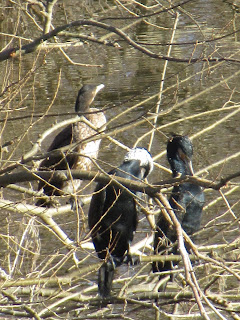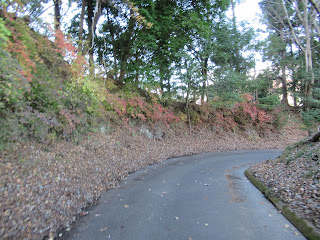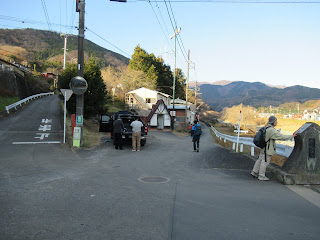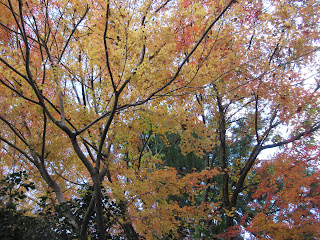Pre-emergency measures again for Kanagawa … OK. Let’s visit a place where wings let the owner of the tool fly away from enclosed atmosphere … I mean, a place good for bird watching. In any case, winter is the best time in Japan to have a quiet conversation with wild birds. Many birds come to our relatively mild climate from far away (like Siberia) or snowing mountains. Deciduous trees have shed their leaves. Their boned boughs and branches stand out. It is easy for us to find birds parching on them. Besides, to enjoy bird watching, we have to go to open-sky space in nature, preferably solo, or maintain our conversation minimum. PERFECT activity for the pre-emergency against COVID-19! … Anyway, today I tell you my adventure of bird watching in suburbia. Yeah, the place we visit today is surrounded by sleepy residential area. Silver lining: the place is SLEEPY and I hope less dangerous to be infected by COVID … Let’s go to Flood-Control Park for Sakai River of Kanagawa Prefecture 神奈川県立境川遊水地公園.
 |
| Unfortunately, there is no bird here … |
 |
| An
exemplar attitude for Pre-emergency measures in Yokohama |
The access to the Park is from Shonandai Station 湘南台駅. It’s a quiet terminal station for Odakyu Enoshima Line 小田急江ノ島線, Sotetsu Izumino Line 相鉄いずみ野線 and Yokohama Subway Blue Line 横浜市営地下鉄ブルーライン. Whichever commuter service you take, please leave the station from East Exit H. Just keep on walking straight. In no time, we get across Shonandai Park 湘南台公園 to enter pure housing area. In front of us are railway viaducts of Sotetsu and Yokohama Subway. From that point, our road goes down to the bank of Sakai River 境川. Simply go to the River and we are now at the northern tip of the Park, which is Imada Flood Control Pond 今田遊水地. It’s about 10 minutes relaxing walk from the Station. Welcome to the Flood Control Park of Sakai River!
 |
| We’re here. Simply go ahead … |
 |
| to
cross this traffic light. Over there is Shonanadai Park. |
 |
| Across
the Shonandai Park is standard residential area. Please keep on going to |
 |
| find
railway viaducts over there. Yokohama Subway is coming to Shonandai Station. |
 |
| Below
the viaducts is an entrance to Flood-Control Park for Sakai River. |
 |
| Imada Flood Control Pond 今田遊水地 |
In our neighborhood, the most famous flood-control park is Shin-Yokohama Park where Nissan Stadium stands (; my post on September 18, 2020.) Civil Engineering wise, the idea is the same for Flood Control Park for Sakai River. Sakai River, 52.1km, runs from the City of Machida 町田市, Tokyo, and pours into Sagami Bay 相模湾 at near Enoshima Island 江の島 (; my post on June 30, 2017.) When it departs from Tokyo, the eastern bank of the river is Yokohama for a while until just before it meets with Route #1. Eastern side of today’s Park is in the City of Yokohama, and the western portion is in the City of Fujisawa 藤沢. Almost entire basin of Sakai River now is very urban, mainly boring bed towns for downtown Tokyo and Yokohama. The process of development was housing first, then flood control … Hmmmmmmm, something was wrong, don’t you think? Sakai River runs down not so steep slope. It was flood prone. To build my-sweet-homes, people dug deep its riverbed and concreted banks of almost entire river. The suburbia around it is covered with paved roads and concreted structures. The idea backfired. Soils along Sakai River became under concrete almost entirely. It cannot absorb rainwater anymore. Water simply runs down to the River, which caused floods easily. It is a serious risk for offices and homes. People rethought the strategy to deal with the problem. The construction of flood-control park was started at the beginning of the 21st century. It works. Already in 2004, the flood-control system with overflow dykes in the Park prevented floods downstream. Good, good. When there is no storm, the Park consists of dotting flood control ponds, sports fields and nice mainly paved strolling path.
 |
| Overflow dyke in the Park |
 |
| Along
the dyke, the strolling path is for walkers and bikers. Lots of cyclists use this route in Fujisawa. |
 |
| Flood gate from flood control pond, connecting to Sakai River |
The majority of the path in the Park is barrier-free and flat. If you’re with strollers or wheelchairs, you will not have a serious problem to enjoy the park. The Park has ample parking space capable of welcoming more than 200 cars. 😉 The map of the Park is here. Basically we can start walking from whichever point we like. Having said that, I recommend visiting Information Center near the baseball field. If you understand Japanese, they have good panel exhibitions explaining the history and environment of the Park. Even if you’re challenged in Japanese, they have interesting display for fossils found during the construction works. These discoveries tell the place was the bottom of sea some 130 thousand years ago. Next to such presentations, there are aquariums showing the present dwellers of Sakai River and the ponds of the Park, including endangered Japanese ricefish. Oh, if you plan to use sports fields (with coin-operated showers) here, such as baseball ground, football field, athletics tracks, or tennis court, this is the office for making reservation. They also rent wheelchairs. For the detail, please check their HP here. Plus, this site tells us the existence of lunch delivery service to the Park from nearby cafes. 😊
 |
| Beautiful fossils … |
 |
| Paths in the park are like this in general. |
 |
| Baseball Field |
 |
| In the
middle of the park, there is this elegant Saguimai Bridge 鷺舞橋, which means “A bridge where herons dance.” |
 |
| And at
the foot of the bridge are toilets and showers. Could you see the blue indicator on the wall? It says in 2016 the flood water came this high by a typhoon. |
It’s a relaxing waterfront not only for humans, but also for wildlife. Inside the Park Sakai River runs through and 3 flood control ponds-cum-biotopes exist along the River. Although I told you Sakai River basin is almost entirely concreted, the area around the Park preserves thin strips of agricultural land and petit forests … a sort of mass of trees beyond which from the other side we can recognize rows of housing roofs. For small wildlife, it is enough to thrive. The place is famous for its families of herons. Majorities of them stays here all year long. Migratory birds also make the Park their seasonal home. Young barn swallows have their “summer school” in the Park before they leave to Southeast Asia. In winter, many ducks come from Siberia to mate and nurse chicks. Information Center has monthly bird-watching program … Though due to Covid, it is suspended now. Let’s keep crossing our fingers for 2022 … for information of educational programs in the Park, please check here. The Center also leases binoculars for birdwatching, free of charge. Please bring your photo-ID to use the service.
 |
| Lots of Great cormorant … |
 |
| Eurasian
coots are busy on shore for lunch. It is said that their numbers are growing these couple of years in our neighborhood. |
 |
| A beautiful Grey heron |
 |
| I
don’t know why this Little egret kept up its left leg for a while and did not move at all … |
 |
| I think it is Long-toed stint. |
I was a sort of amazed to know these biotopes were man-made. In information Center, we can see photos of the area before the park development. It took less than 20 years to receive these wild bird families. Wow. Actually, not only professional landscapers, but volunteers, including college kids from nearby campuses, regularly work to maintain the biotopes in the Park. In the end these ponds are part of the flood controlling system. We need to make them alive in order to maintain safe suburbia … Something very typical nature-human relationship in our neighborhood of Yokohama, I think.
 |
| I
could not identify the guy on the right corner … Heeeeelp! |
If you find environmental issues in Flood-Control Park for Sakai River of Kanagawa Prefecture 神奈川県立境川遊水地公園, please make a contact with
Information Center, Flood-Control Park for Sakai River of Kanagawa Prefecture
神奈川県立境川遊水地公園情報センター
5-5 Shimoiida-cho, Izumi Ward, Yokohama, 245-0017
〒245-0017 横浜市泉区下飯田町5-5
Phone: 045-805-0223
FAX: 045-805-3917
































